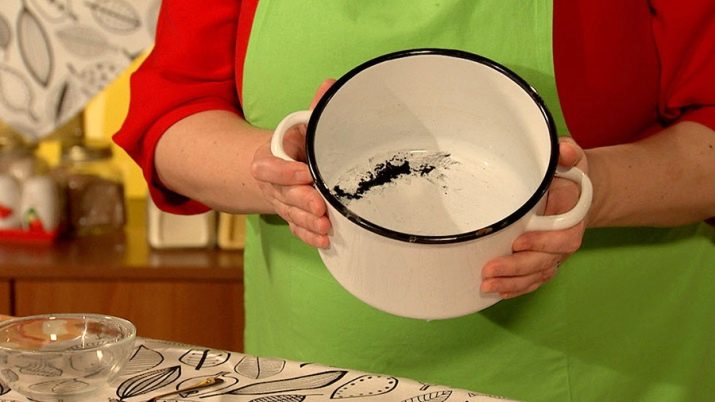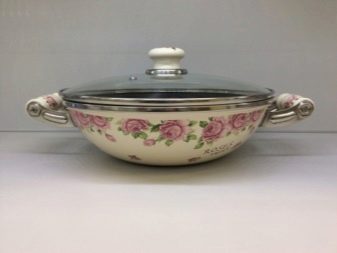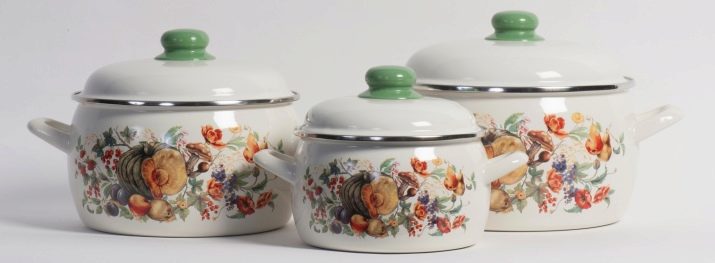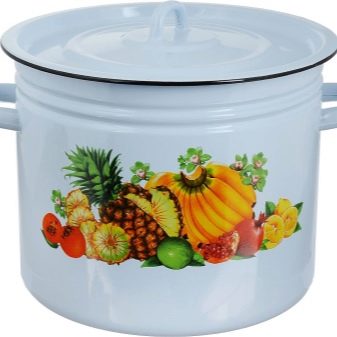Enameled dishes: the best manufacturers, selection criteria

The well-known enamelware for several decades has not yielded to its positions in the arsenal of housewives, still outstripping in popularity such newfangled materials as heat-resistant glass and high-quality alloys. Pots and other containers made of this heat-resistant material are optimal for preparing a wide variety of dishes, and with careful treatment they can faithfully serve for a very long time.
Peculiarities
According to statistics, from the very beginning of the new century in Russia, albeit slowly, the sales of tableware have been growing. At the same time, this tendency is especially noticeable in relation to kitchen utensils made of a variety of metal alloys and coated with special enamel. The secret of the popularity of such products is due to several factors:
- the versatility of kitchen utensils - they are suitable for preparing the first, second and third courses;
- a wide selection of shades and designs - everyone can choose such dishes that will fully match the style of the kitchen;
- relatively low prices, so that the purchase of such dishes will not make a noticeable gap in the family's budget.

Despite the abundance of the advantages of enameled dishes, many still perceive it as an indispensable attribute of the kitchens of the Soviet period. Such a view is completely in vain - technologies do not stand still, therefore today the category of goods in question is made only from the highest quality materials: cast iron, carbon steel or stainless steel, and enamel is applied to protect the metal from corrosion and rust.
The enamel usually contains silicic acid, as well as sodium, potassium or lead oxides.
When making pots with an enamel coating, manufacturers most often use a rather impractical method of applying the mixture - such dishes are inexpensive, but the coating wears off quickly, cracks and chips appear on it. Products of reliable brands are made in a different way, usually using immersion technology - you can distinguish such dishes by their price, as well as by the presence of 3-4 dark dots scattered on the outer surface of the pots in those places where fasteners were fixed before processing.

Thanks to the inclusion of various oxides, dishes of a wide variety of shades can be obtained. So, when mixing the components of the mixture with chromium oxides, a red color is obtained, and blue can be achieved by including tin oxides in the coating structure.
Products with an enamel coating can be used for preparing first courses, as well as side dishes and compotes. But experienced cooks do not recommend cooking porridge, syrups and jams in them, since the products in them can burn.

Advantages and disadvantages
The main advantages of enameled cookware include:
- increased resistance to alkalis and acids;
- the enamel can be easily cleaned using the most common cleaning agents and a soft sponge;
- the coating has pronounced heat-resistant properties that remain throughout the entire period of use;
- the cookware is suitable both for traditional gas and electric stoves and for induction hobs;
- affordable price;
- aesthetic design.

However, it was not without its drawbacks:
- dairy and viscous products can burn when cooking in such a container;
- when cleaning with abrasive products and metal brushes, the coating is damaged;
- enamel does not tolerate temperature extremes that lead to cracking.

Do not forget that enamel is relatively fragile, so it often breaks off when hit or dropped, and coating chips are one of the most common problems when working with pots and kettles.
If you notice such damage, especially on the inside, then it is better to throw out the product, otherwise the food will come into direct contact with the metal and, at best, the dishes will acquire an unpleasant aftertaste, and at worst, significant harm will be caused to human health.

Comparison with other materials
As experienced housewives testify, enameled dishes have many advantages in comparison with similar products made of cast iron, uncoated stainless steel, as well as aluminum and other raw materials. Pans made made of aluminum, when interacting with organic compounds, they begin to darken, therefore, when stored in them, products quickly lose their attractive appearance.
Ceramic tableware when used, it requires the mandatory use of a flame divider, in addition, the cost of such dishes is several times higher than the prices for enameled containers. Cast iron dishes can be cleaned exclusively by hand, as they quickly rust when using dishwashers. Medical steels take too long to heat up, so over time streaks and unattractive stains appear on the surface.


Very often enameled pots are compared to their counterparts. stainless steel - both materials are equally represented in kitchens. However, stainless steel pots with thin walls deform rather quickly, and with thick ones they are very expensive.
Stainless steel kitchen utensils are often supplemented with plastic handles and holders on the lid, which makes it impossible to use the container in the oven.At the same time, such dishes take longer to cool down and are resistant to chemical reagents. When choosing this or that product, the list of dishes that you are going to cook plays a role.


Popular brands
It is believed that the highest quality enamelware is products from Japan. However, this is a misconception - as in the case of Russian manufacturers, Japanese products can also be of low quality, therefore, you should pay attention primarily not to the country of origin, but to the brand. Of the well-proven industries, the following can be distinguished.
Ejiry
One of the largest Japanese firms engaged in the production of enameled cookware. Outwardly, it is well recognizable by the abundance of patterns and floral ornaments on a light background. Such dishes are of high quality, which is due to the use of glass enamels with the addition of powdered sugar.




Japonica
A series of these dishes is designed in the Provence style, therefore, it is distinguished by the use of delicate colors and an abundance of romantic flower patterns. Enamel for the manufacture of such pans is produced from the highest quality and natural materials.




Thermosol
Finnish cookware is in great demand, especially the Termosol brand, which is one of the world leaders in the kitchen utensil production market. The basis for the manufacture of enameled dishes is carbon steel, and it is covered with a dense layer of enamel, which can withstand fairly high temperatures without any deformation and damage to the integrity of the coating.



Metrot
In Europe, for a long time, the dishes of the company Metrot (Serbia) have been in stable high demand, the main advantages of which include exceptional quality, environmental friendliness, stylish colorful design. The enamel coating is made of natural materials, applied in an even layer and does not require special maintenance. Under this brand, not only pots are produced, but also teapots, Turks and the most ordinary ladles and ladles.






The best user reviews earned products from Germany.
By the way, domestic manufacturers also make utensils, which are practically not inferior in quality to their imported counterparts. Among the most popular are “Novomoskovsk utensils” and “Lysva enamels”. A distinctive feature of the products - high quality that has been maintained for almost a century.

Among other domestic enterprises, the following two can be noted.
- "Enamel" Is a company from Magnitogorsk, which specializes in the production of high-quality and very interesting, in terms of decor, tableware. Thanks to the use of high-tech equipment, the manufacturer is able to maintain the cost of the tableware at an affordable level.
- "Stalemal" - a subsidiary of the large metallurgical tycoon Severstal. The dishes of this brand are presented in the widest range and are distinguished by truly European quality.


How to choose?
The purchase of kitchen utensils and utensils is a very responsible occupation, so you need to take your choice seriously. Experts give several recommendations to distinguish high-quality enamel cookware from its cheap and short-lived counterparts.
- The enamel layer should be smooth and shiny.
- If you notice spots on the coating, all sorts of swelling, cracks, chips and partially bare metal - feel free to refuse the purchase, the food cooked in it will be of little use, perhaps even dangerous.
- If you choose thick-walled enamel cookware, it will be much more impact-resistant, but it will also weigh much heavier.
- Pay attention to the method of application of the material - by spraying or dipping. The second is undoubtedly more preferable.
- When buying enameled dishes, be sure to look inside the container and evaluate the shade of the coating - normally it should be white, grayish-blue or black. But if you have a yellow or reddish coating in front of you, then most likely it contains chemical compounds that are potentially dangerous to the human body.

Be sure to make sure that there are marks of compliance with GOST requirements on the packaging, ask the seller for a certificate of compliance of the product with sanitary and hygienic standards.
Usage Tips
Housewives are often interested in the question - is it possible to bake food in an enamel pan. It is possible, but at the same time, the established temperature regime and the quality of the coating are of great importance. Not every enamel pot can be put into the oven.
- Only dishes with thick walls are suitable for baking, the coating must be intact, no cracks or chips should be visible.
- You shouldn't put the pan directly into a hot oven, it is better to heat it up gradually.
- Enamel cookware can only be used at temperatures up to 250 degrees.

An equally relevant question is whether it is possible to marinate food in such a pan. The fact is that usually certain concentrations of organic acids are present in marinades, so not every metal will be suitable for such purposes.
For lovers of barbecue outdoors, preference should be given to large pots with high quality glass-ceramic coating - such compositions will not give the products a characteristic metallic taste.

Read the recommendations for using such utensils.
- Before using the enamel cookware for the first time, it must be hardened. To do this, a concentrated saline solution (2 tablespoons of salt per liter of water) is poured into it and brought to a boil. Then they are cooled naturally and washed.
- Do not expose the enamel to sudden changes in temperature, otherwise it may crack.
- Do not leave enamelled pots and other containers in the cold, as the enamel begins to deteriorate during the crystallization of water.
- When cooking food, do not tap the sides of the container with a metal spoon or scoop.
- Please note that pans with a large capacity do not need to be placed on a weak cooking zone.
- If you get into trouble and food burns in your new pot, don't despair. Just fill it with a solution of salt and water at the rate of 1 tbsp. l. 1.5 liters and leave for 2-3 hours, after that you can easily wash off all adhering food residues with a regular sponge.
- You can remove carbon deposits and descale the pan at home using the Komet and Pemolux powders. First you need to wash the pan, apply a cleaning powder to the stains, rub it with the hard side of a sponge and leave it in a bowl of hot water for a couple of hours, then just rinse it off under running water.

Subject to all the rules for the use of kitchen utensils with an enamel coating, it will serve you and your family for a very long time, preserving its original appearance.
For more information on how to clean enamel pots, see the next video.








